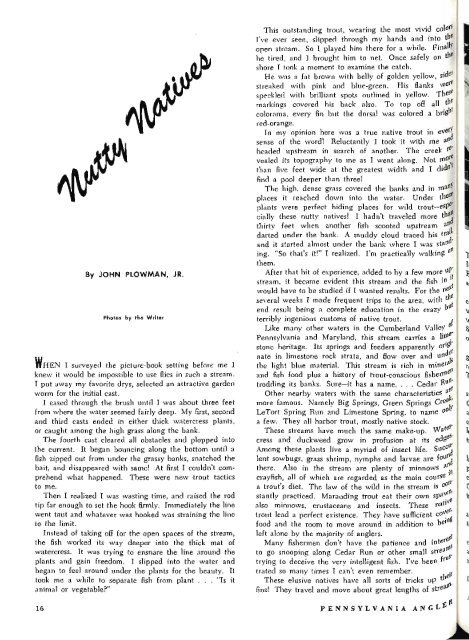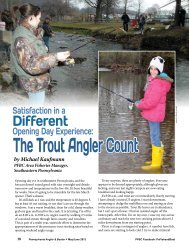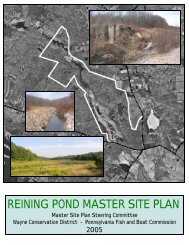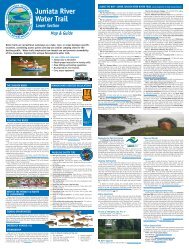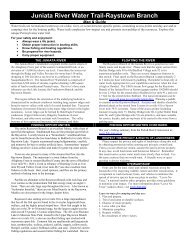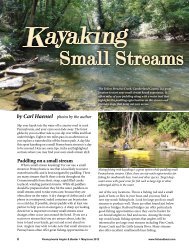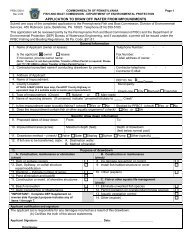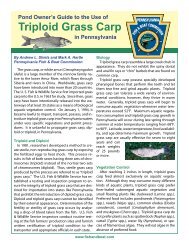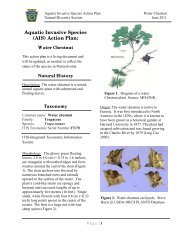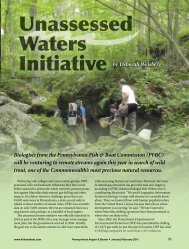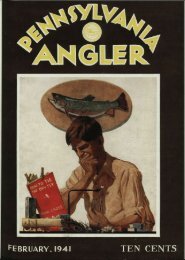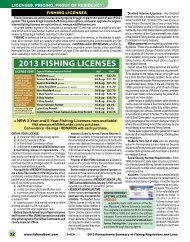m&M: - Pennsylvania Fish and Boat Commission
m&M: - Pennsylvania Fish and Boat Commission
m&M: - Pennsylvania Fish and Boat Commission
You also want an ePaper? Increase the reach of your titles
YUMPU automatically turns print PDFs into web optimized ePapers that Google loves.
By JOHN PLOWMAN, JR.<br />
Photos by the Writer<br />
w HEN I surveyed the picture-book setting before me I<br />
knew it would be impossible to use flies in such a stream.<br />
I put away my favorite drys, selected an attractive garden<br />
worm for the initial cast.<br />
I eased through the brush until I was about three feet<br />
from where the water seemed fairly deep. My first, second<br />
<strong>and</strong> third casts ended in either thick watercress plants,<br />
or caught among the high grass along the bank.<br />
The fourth cast cleared all obstacles <strong>and</strong> plopped into<br />
the current. It began bouncing along the bottom until a<br />
fish zipped out from under the grassy banks, snatched the<br />
bait, <strong>and</strong> disappeared with same! At first I couldn't comprehend<br />
what happened. These were new trout tactics<br />
to me.<br />
Then I realized I was wasting time, <strong>and</strong> raised the rod<br />
tip far enough to set the hook firmly. Immediately the line<br />
went taut <strong>and</strong> whatever was hooked was straining the line<br />
to the limit.<br />
Instead of taking off for the open spaces of the stream,<br />
the fish worked its way deeper into the thick mat of<br />
watercress. It was trying to ensnare the line around the<br />
plants <strong>and</strong> gain freedom. I slipped into the water <strong>and</strong><br />
began to feel around under the plants for the beauty. It<br />
took me a while to separate fish from plant . . . "Is it<br />
animal or vegetable?"<br />
16<br />
This outst<strong>and</strong>ing trout, wearing the most vivid colo* 5<br />
I've ever seen, slipped through my h<strong>and</strong>s <strong>and</strong> into 9<br />
open stream. So I played him there for a while. Finally<br />
he tired, <strong>and</strong> I brought him to net. Once safely on tb*<br />
shore I took a moment to examine the catch.<br />
He was a fat brown with belly of golden yellow, sio e<br />
streaked with pink <strong>and</strong> blue-green. His flanks we* 8<br />
speckled with brilliant spots outlined in yellow. The 8<br />
markings covered his back also. To top off all %<br />
colorama, every fin but the dorsal was colored a brig 11<br />
red-orange.<br />
In my opinion here was a true native trout in evefsense<br />
of the word! Reluctantly I took it with me a °<br />
headed upstream in search of another. The creek i&<br />
vealed its topography to me as I went along. Not m" f<br />
than five feet wide at the greatest width <strong>and</strong> I did 11<br />
find a pool deeper than three!<br />
The high, dense grass covered the banks <strong>and</strong> in m a °'<br />
places it reached down into the water. Under the 8<br />
plants were perfect hiding places for wild trout—esp e<br />
cially these nutty natives! I hadn't traveled more th*<br />
thirty feet when another fish scooted upstream a0 .<br />
darted under the bank. A muddy cloud traced his trtfl<br />
<strong>and</strong> it started almost under the bank where I was stan 0<br />
ing. "So that's it!" I realized. I'm practically walking °<br />
them.<br />
After that bit of experience, added to by a few more w<br />
stream, it became evident this stream <strong>and</strong> the fish i n<br />
would have to be studied if I wanted results. For the n e<br />
several weeks I made frequent trips to the area, with Ǥ<br />
end result being a complete education in the crazy P.<br />
terribly ingenious customs of native trout. i<br />
Like many other waters in the Cumberl<strong>and</strong> Valley<br />
<strong>Pennsylvania</strong> <strong>and</strong> Maryl<strong>and</strong>, this stream carries a M 1 * 1 ,<br />
stone heritage. Its springs <strong>and</strong> feeders apparently oiW<br />
nate in limestone rock strata, <strong>and</strong> flow over <strong>and</strong> un ,,<br />
the light blue material. This stream is rich in minef^<br />
<strong>and</strong> fish food plus a history of trout-conscious fisherru 6<br />
trodding its banks. Sure—it has a name, . . . Cedar B u<br />
Other nearby waters with the same characteristics a<br />
more famous. Namely Big Springs, Green Springs Cre e '<br />
LeTort Spring Run <strong>and</strong> Limestone Spring, to name °^'<br />
a few. They all harbor trout, mostly native stock.<br />
These streams have much the same make-up. W ate<br />
cress <strong>and</strong> duckweed grow in profusion at its<br />
Among these plants live a myriad of insect life. SuC c ,<br />
lent sowbugs, grass shrimp, nymphs <strong>and</strong> larvae are f° u i<br />
there. Also in the stream are plenty of minnows 2°<br />
crayfish, all of which are regarded as the main course<br />
a trout's diet. The law of the wild in the stream is c °<br />
stantly practiced. Marauding trout eat their own sp avV '<br />
also minnows, crustaceans <strong>and</strong> insects. These r> atl<br />
trout lead a perfect existence. They have sufficient co^ '<br />
food <strong>and</strong> the room to move around in addition to be'<br />
left alone by the majority of anglers. t<br />
Many fishermen don't have the patience <strong>and</strong> inte r<br />
to go snooping along Cedar Run or other small stre a<br />
trying to deceive the very intelligent fish. I've been t r<br />
trated so many times I can't even remember. ..<br />
These elusive natives have all sorts of tricks up tJ1<br />
fins! They travel <strong>and</strong> move about great lengths of stre a<br />
it<br />
PENNSYLVANIA ANGL t*


